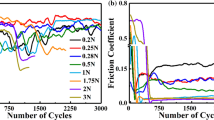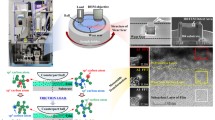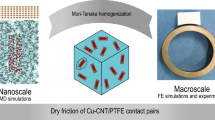Abstract
The effects of load and temperature on the friction between crystalline cotton cellulose and chromium in vacuum were investigated utilizing ReaxFF molecular dynamics. Simulation results indicate that a new chemical bond, Cr=O bond, is formed between the sliding friction interface. In the initial stage, the friction force is determined by the number of atoms in contact with the interface. Then, the friction force depends on the number of atoms of cellulose nested in the chromium matrix at the contact interface. It is positively correlated with load and temperature. Under low load, with the formation of the Cr=O bond, the surface structure of the chromium matrix is damaged. With the increase of load, more Cr=O bonds are formed between the contact interfaces, which leads to more profound damage to the surface structure of the chromium layer. This work systematically introduces the influence mechanism of load and temperature on the friction behavior of crystalline cotton cellulose with chromium, thus providing a new perspective on the study of frictional wear mechanism between cotton cellulose and metal.










Similar content being viewed by others
References
Bogdanovic, G., Tiberg, F., Rutland, M.W.: Sliding friction between cellulose and silica surfaces. Langmuir 17, 5911–5916 (2001). https://doi.org/10.1021/la010330c
Nordgren, N., Eronen, P., Österberg, M., Laine, J., Rutland, M.W.: Mediation of the nanotribological properties of cellulose by chitosan adsorption. Biomacromol 10, 645–650 (2009). https://doi.org/10.1021/bm801467w
Xie, T., Yang, H.P., Hui, Y.: Numerical simulation of the process of friction and wear. Lubr. Eng. 38, 88–92 (2013)
Li, L.R., Luo, L., Wang, B.F.: An overview on classical molecular dynamics simulation. Heat Treat. Technol. Equip. 33, 53–57 (2012). https://doi.org/10.3969/j.issn.1671-4776.2005.03.009
Liu, P., Han, X.L., Sun, D.L., Wang, Q.: Research progress in the application of molecular dynamics simulation in the frictional wear of materials. Mater. Sci. Technol. 25, 26–34 (2017). https://doi.org/10.11951/j.issn.1005-0299.20160422
Wen, Y.H., Zhu, R.Z., Wang, C.Y.: An overview on molecular dynamics simulation. Adv. Mech. 33, 65–73 (2003). https://doi.org/10.3321/j.issn:1000-0992.2003.01.008
Zhao, S., Li, J.F., Zhou, Y.H.: Molecular dynamics simulation and its application in the materials science. Mater. Rev. 25, 5–8 (2007). https://doi.org/10.3321/j.issn:1005-023X.2007.04.002
Neyertz, S., Pizzi, A., Merlin, A., Maigret, B., Brown, D., Deglise, X.: A new all-atom force field for crystalline cellulose I. J. Appl. Polym. Sci. 78, 1939–1946 (2000). https://doi.org/10.1002/1097-4628(20001209)78:11%3c1939::AID-APP130%3e3.0.CO;2-9
Wang, X.M., Chen, H., Chen, D.F.: Dynamics analysis and comparison of two types dumbbell molecular models. J. Qingdao Univ. (Natural Science Edition). 23, 36–40 (2010). https://doi.org/10.3969/j.issn.1006-1037.2010.01.009
Muthoka, R.M., Kim, H.C., Kim, J.W., Zhai, L.D., Panicker, P.S., Kim, J.: Steered pull simulation to determine nanomechanical properties of cellulose nanofiber. Materials. 13, 710 (2020). https://doi.org/10.3390/ma13030710
Saitoh, K.I., Ohno, H., Matsuo, S.: Structure and mechanical behavior of cellulose nanofiber and micro-fibrils by molecular dynamics simulation. Soft Nanosci. Lett. 3, 58–67 (2013). https://doi.org/10.4236/snl.2013.33011
Bochkareva, S.A., Panin, S.V., Lyukshin, B.A., Lyukshin, P.A., Aleksenko, V.O.: Simulation of frictional wear with account of temperature for polymer composites. Phys. Mesomech. 23, 147–159 (2020)
Yuan, S., Guo, X.G., Mao, Q., Guo, J., Guo, D.M.: Effects of pressure and velocity on the interface friction behavior of diamond utilizing ReaxFF simulations. Int. J. Mech. Sci. 191, 106096 (2020). https://doi.org/10.1016/j.ijmecsci.2020.106096
Weiss, M., Majchrzycki, Ł, Borkowska, E., Cichomski, M., Ptak, A.: Nanoscale dry friction: dependence on load and sliding velocity. Tribol. Int. 162, 107133 (2021). https://doi.org/10.1016/j.triboint.2021.107133
Rubin, M.B., Nadler, B.: An elastic–inelastic model for dry friction with a smooth transition. Int. J. Eng. Sci. 168, 103456 (2021). https://doi.org/10.1016/j.ijengsci.2021.103546
Tsuneyuki, S.: Computer simulation of inorganic structures with first-principle interatomic potentials. Acta Crystallogr A Found Crystallogr 49, 5 (1993). https://doi.org/10.1107/S0108767378099845
Van Duin, A.C.T., Dasgupta, S., Lorant, F., Goddard, W.A.: ReaxFF: a reactive force field for hydrocarbon. J. Phys. Chem. A 105, 9396–9409 (2001). https://doi.org/10.1021/jp004368u
Leven, I., Hao, H.X., Tan, S.C., Guan, X.Y., Penrod, K.A., Akbarian, D., Evangelisti, B., Hossain, M.J., Islan, M.M., Koski, J.P., Moore, S., Aktulga, H.M., Van Duin, A.C.T., Head-Gordon, T.: Recent advances for improving the accuracy, transferability, and efficiency of reactive force fields. J. Chem. Theory Comput. 17, 3237–3251 (2021). https://doi.org/10.1021/acs.jctc.1c00118
Hahn, S.H., Liu, H.S., Kim, S.H., Van Duin, A.C.T.: Atomistic understanding of surface wear process of sodium silicate glass in dry versus humid environments. J. Am. Ceram. Soc. 103, 3060–3069 (2020). https://doi.org/10.1111/jace.17008
Wang, M., Duan, F.L., Mu, X.J.: Effect of surface silanol groups on friction and wear between amorphous silica surfaces. Langmuir 35, 5463–5470 (2019). https://doi.org/10.1021/acs.langmuir.8b04291
Yue, D.C., Ma, T.B., Hu, Y.Z., Yeon, J., Van Duin, A.C.T., Wang, H., Luo, J.B.: Tribochemical mechanism of amorphous silica asperities in aqueous environment: a reactive molecular dynamics study. Langmuir 31, 1429–1436 (2015). https://doi.org/10.1021/la5042663
Zhang, X.M., Tschopp, M.A., Shi, S.Q., Cao, J.: Molecular dynamics simulations of the glass transition temperature of amorphous cellulose. Appl. Mech. Mater. 214, 7–11 (2012)
Shin, Y.K., Kwak, H., Vasenkov, A.V., Sengupta, D., Van Duin, A.C.T.: Development of a ReaxFF reactive force field for Fe/Cr/O/S and application to oxidation of butane over a pyrite-covered Cr2O3 catalyst. ACS Catal. 5, 7226–7236 (2015). https://doi.org/10.1021/acscatal.5b01766
Van Duin, A.C.T., Strachan, A., Stewman, S., Zhang, Q.S., Xu, X., Goddard, W.A.: ReaxFFSiO reactive force field for silicon and silicon oxide systems. ACS Catal. 107, 3803–3811 (2003). https://doi.org/10.1021/jp0276303
Dai, L., Minn, M., Satyanarayana, N., Sinha, S.K., Tan, V.B.C.: Identifying the mechanisms of polymer friction through molecular dynamics simulation. Langmuir 27, 14861–14867 (2011). https://doi.org/10.1021/la202763r
Yew, Y.K., Minn, M., Sinha, S.K., Tan, V.B.C.: Molecular simulation of the frictional behavior of polymer-on-polymer sliding. Langmuir 27, 5891–5898 (2011). https://doi.org/10.1021/la201167r
Zhan, S.P., Xu, H.P., Duan, H.T., Pan, L., Jia, D., Tu, J.S., Liu, L., Li, J.: Molecular dynamics simulation of microscopic friction mechanisms of amorphous polyethylene. Soft Matter 15, 8827–8839 (2019). https://doi.org/10.1039/C9SM01533G
Zhou, M.Y., Fu, L., Jiang, F.Z., Jiang, B.Y., Drummer, D.: Atomistic investigation on the wetting behavior and interfacial joining of polymer-metal interface. Polymers 12(8), 1696 (2020). https://doi.org/10.3390/polym12081696
Howard, R.H., Meunier, M.: Molecular Modelling with Materials Studio®. CRC Press (2019)
Zhang, X.M., Tschopp, M.A., Horstemeyer, M.F., Shi, S.Q., Cao, J.: Mechanical properties of amorphous cellulose using molecular dynamics simulations with a reactive force field. Int. J. Model. Ident. Control 18, 211–217 (2013). https://doi.org/10.1504/IJMIC.2013.052814
Zhang, Y.: The role of chromium in metal materials. Mech. Eng. (1999). https://doi.org/10.3969/j.issn.1002-2333.1999.03.040
Wang, W.Z.: Hard chromium plating for common metals. Electroplat. Pollut. Control. (2006). https://doi.org/10.3969/j.issn.1000-4742.2006.04.013
Mazeau, K., Heux, L.: Molecular dynamics simulations of bulk native crystalline and amorphous structures of cellulose. J. Phys. Chem. B 107, 2394–2403 (2003). https://doi.org/10.1021/jp0219395
Poma, A.B., Chwastyk, M., Cieplak, M.: Coarse-grained model of the native cellulose Iα and the transformation pathways to the Iβ allomorph. Cellulose 23, 1573–1591 (2016). https://doi.org/10.1007/s10570-016-0903-4
Nishiyama, Y., Langan, P., Chanzy, H.: Crystal structure and hydrogen-bonding system in cellulose I(alpha) from synchrotron X-ray neutron fiber diffraction. J. Am. Chem. Soc. 124, 9074–9082 (2002). https://doi.org/10.1021/ja037055w
Lee, C.M., Kubicki, J.D., Fan, B.X., Zhong, L.H., Jarvis, M.C., Kim, S.H.: Hydrogen-bonding network and OH stretch vibration of cellulose: comparison of computational modeling with polarized IR and SFG spectra. J. Phys. Chem. B 119, 15138–15149 (2015). https://doi.org/10.1021/acs.jpcb.5b08015
Sorieul, M., Dickson, A., Hill, S.J., Pearson, H.: Plant fibre: molecular structure and biomechanical properties, of a complex living material, influencing its deconstruction towards a biobased composite. Materials. 9, 618 (2016). https://doi.org/10.3390/ma9080618
Grazulis, S., Daskevic, A., Merkys, A., Chateigner, D., Lutterotti, L., Quiros, M., Serbryanaya, N.R., Moeck, P., Downs, R.T., Bail, A.L.: Crystallography open database (COD): an open-access collection of crystal structures and platform for world-wide collaboration. Nucleic Acids Res. 40, D420–D427 (2012). https://doi.org/10.1093/nar/gkr900
Florian, M.P.: Coarse-Graining in polymer simulation: from the atomistic to the mesoscopic scale and back. ChemPhysChem 3, 754–769 (2002). https://doi.org/10.1002/1439-7641(20020916)3:9%3c754::AID-CPHC754%3e3.0.CO;2-U
Zhang, Y.Q., Luo, S.L., Zhang, H.: Dynamic analysis of spindles in picking process with intermittent excitations. Noise Vib. Control. 37(6), 41-45,157 (2017). https://doi.org/10.3969/j.issn.1006-1355.2017.06.008
Liu, L.C., Liu, Y., Zybin, S.V., Sun, H., Goddard, W.A.: ReaxFF-/g: Correction of the ReaxFF Reactive Force Field for London Dispersion, with Applications to the Equations of State for Energetic Materials. J. Phys. Chem. A 115, 11016–11022 (2011). https://doi.org/10.1021/jp201599t
Plimpton, S.: Fast parallel algorithms for short-range molecular dynamics. J. Comput. Phys. 117, 1–19 (1995). https://doi.org/10.1006/jcph.1995.1039
Stukowski, A.: Visualization and analysis of atomistic simulation data with OVITO–the Open Visualization Tool. Modell. Simul. Mater. Sci. Eng. 18, 2154–2162 (2010). https://doi.org/10.1088/0965-0393/18/1/015012
Zhang, Y.Q., Wang, W., Liao, J.A.: Wear failure analysis on spindle of cotton picker. Trans. Chin. Soc. Agric. Eng. 33, 45–50 (2017). https://doi.org/10.11975/j.issn.1002-6819.2017.18.006
Funding
This study was supported by the Xinjiang Production and Construction Corps Research Program (Nos. 2018AB007; 2021CB036).
Author information
Authors and Affiliations
Contributions
ZY designed the calculations and performed the writing—original draft and conceptualization; YQZ was responsible for the funding acquisition and methodology; KXJ and WJF performed writing—review & editing; HC was responsible for supervision. All authors participated in the discussions and manuscript preparation.
Corresponding author
Ethics declarations
Conflict of interest
The authors declared that they have no conflicts of interest to this work. We declare that we do not have any commercial or associative interest that represents a conflict of interest in connection with the work submitted.
Additional information
Publisher's Note
Springer Nature remains neutral with regard to jurisdictional claims in published maps and institutional affiliations.
Supplementary Information
Below is the link to the electronic supplementary material.
Rights and permissions
About this article
Cite this article
Yan, Z., Jiang, K., Fang, W. et al. Molecular Dynamics Simulation of Sliding Friction Between Crystalline Cotton Fiber and Cr. Tribol Lett 69, 153 (2021). https://doi.org/10.1007/s11249-021-01533-8
Received:
Accepted:
Published:
DOI: https://doi.org/10.1007/s11249-021-01533-8




